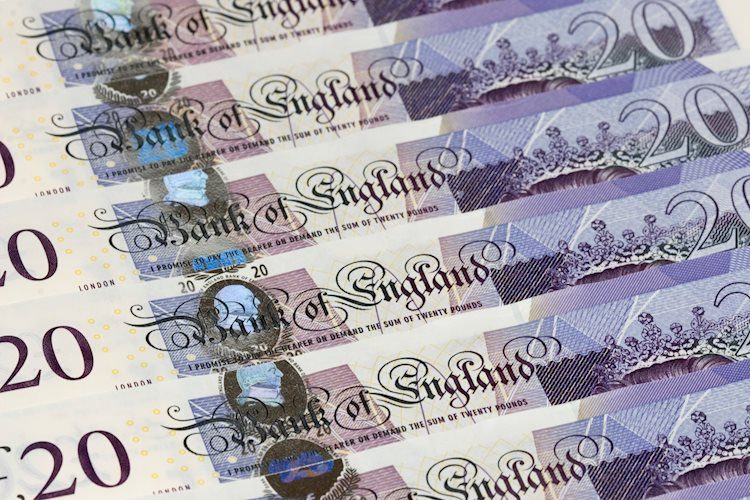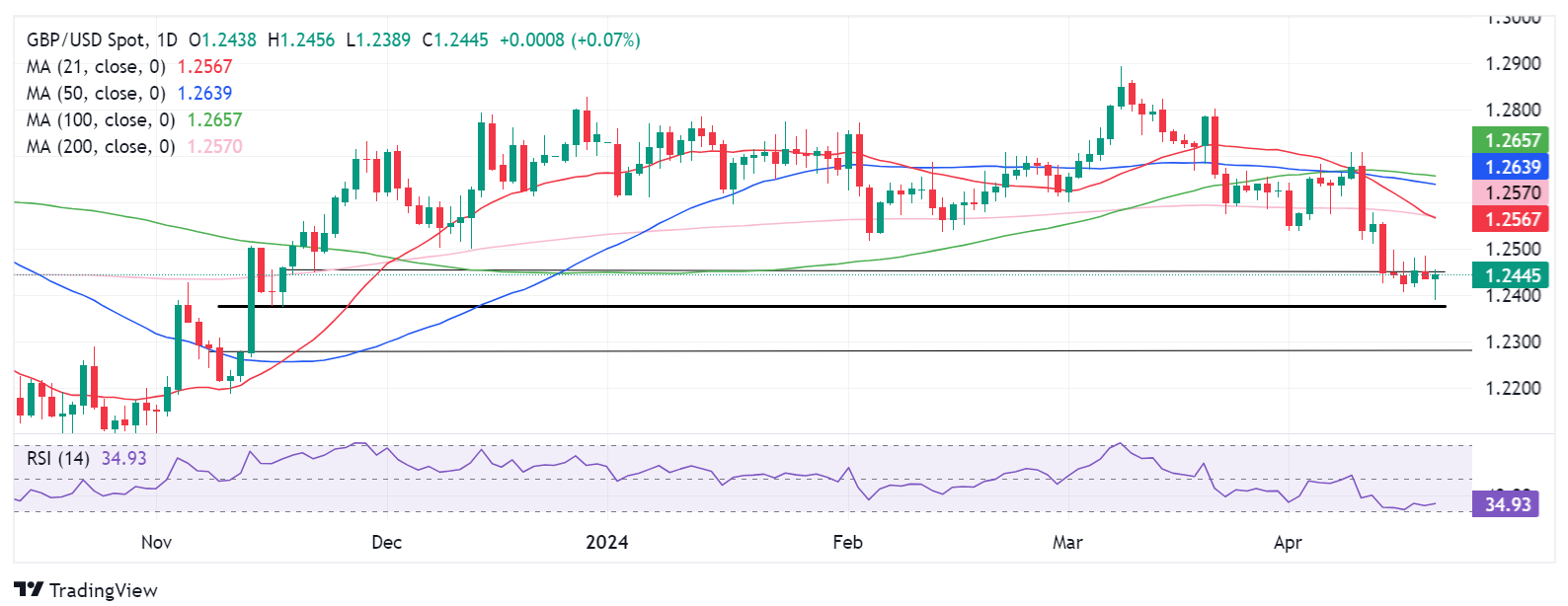
- The Pound Sterling hit five-month lows below 1.2400 against the US Dollar.
- GBP/USD is set for more pain, with US advance GDP due in the week ahead.
- The Pound Sterling tested 1.2400, daily RSI still remains in the negative zone.
The Pound Sterling (GBP) accelerated its south run against the US Dollar (USD), knocking the GBP/USD pair to levels unseen since late November 2023.
Pound Sterling dumped on Middle East tensions, hawkish Fed outlook
Mounting fears over a fully blown-out war in the Middle East combined with a hawkish shift in the US Federal Reserve (Fed) interest-rate outlook doubled up the demand for the US Dollar at the expense of the Pound Sterling. The underlying cautious environment throughout the week weighed on the risk currencies such as the British Pound.
Market participants began the week digesting Saturday’s Iran’s drone attacks on Israel. Citing the Islamic Revolutionary Guard Corps, Iran’s state-run media reported that dozens of drones were fired in retaliation to the suspected Israeli attack on Iran’s consulate in Damascus on 1 April.
Since then, investors remained fearful of whether Iran’s unprecedented strike on Israel could fuel a wider regional conflict. Even though Iran repeatedly said that it seeks no further escalation of its conflict with Israel, the Western response to the Iranian attack remains a cause of concern for broader markets. White House National Security Adviser Jake Sullivan announced late Tuesday that the US will impose new sanctions against Iran’s missile and drone program, entities supporting Islamic Revolutionary Guard Corp. (IRGC) and the Defense Ministry.
Risk-aversion intensified toward the midweek after markets entered “sell everything” mode in response to a surprise hawkish tone in Fed Chair Jerome Powell’s speech on Tuesday. Powell said recent inflation data, with three months of upside surprises, had not given policymakers enough confidence to ease policy soon. He added that the central bank may need to keep rates higher for longer than previously thought. His comments further squashed expectations of Fed rate cuts this year, spiking up the US Dollar.
Markets slashed bets for June and July Fed rate cuts, although chances of a September Fed rate reducton still stand at about 65%, according to the CME Group’s FedWatch Tool. Besides Powell, several other Fed policymakers continued to express concerns over sticky inflation, backing the view of a delayed and slower policy pivot.
On Friday, risk sentiment took a big hit after ABC News confirmed, citing a US official, that Israel fired missiles on Iran’s central city of Isfahan. Iran’s Fars news agency said an explosion was heard at the city airport but the cause was not immediately known. Several Iranian nuclear sites are located in Isfahan province. Against this backdrop, the US Dollar received a fresh boost, while GBP/USD hit a five-month low below the 1.2400 threshold.
From the UK side of the equation, the Pound Sterling tried its luck on a lesser-than-expected cool down in the country’s inflation data for March released on Wednesday but failed to sustain the recovery, as sellers continued to lurk near 1.2500. Consumer Price Index (CPI) rose at an annual pace of 3.2% in March, slower than a 3.4% uptick in February, the data released by the Office for National Statistics (ONS) showed. The data beat the market expectations of a 3.1% increase in the reported period.
Following the UK inflation data release, money markets now fully price in the first Bank of England (BoE) rate cut in November, compared with September previously expected, per Reuters. Meanwhile, Tuesday’s UK employment data had a limited impact on the currency pair. Further, the UK Retail Sales stagnated in March, the Office for National Statistics reported on Friday.
The week ahead: All eyes on US advance GDP
It’s about the US economic data releases in the week ahead, as the UK calendar remains devoid of any significant event, leaving GBPUSD at the mercy of the US Dollar dynamics and the sentiment around the Fed.
Monday is quiet, in terms of data publications, and hence, attention turns toward Tuesday’s S&P Global Preliminary Manufacturing and Services PMI data for April from both the UK and the US. Also, the US New Homes Sales data and Treasury’s Currency Report will entertain traders.
The US Durable Goods Orders data for March will feature on Wednesday, followed by the high-impact Advance first-quarter US Gross Domestic Product (GDP) report on Thursday. The weekly Jobless Claims and Pending Homes Sales will also be released that day.
The Bank of Japan (BoJ) will announce its monetary policy on Friday, which could have a USD/JPY-driven big “rub-off” effect on the US Dollar, eventually influencing GBP/USD price action. Later on Friday, the US will report the monthly Personal Consumption Expenditures (PCE) Price Index for March and the revised University of Michigan (UoM) Consumer Sentiment data for April.
Apart from the data releases, speeches BoE policymakers, as well as, the Middle East geopolitical developments will be closely watched by market participants.
GBP/USD: Technical Outlook
From a short-term technical perspective, GBP/USD remains posied for some more weakness, as the 14-day Relative Strength Index (RSI) indicator holds deep in the negative territory but not yet in the oversold region.
Adding credence to the bearish potential, the 21-day Simple Moving Average (SMA) crossed the 200-day SMA for the downside on Thursday, charting a Bear Cross.
Therefore, a sustained move below the intersection of the November 16 and 17 lows near 1.2375 will trigger a sharp downtrend toward the November 14 low of 1.2266.
If the RSI conditions turn oversold, a meaningful recovery will initiate only on a sustained move above the previous key support-turned resistance of 1.2449.
The net topside hurdle is seen at around 1.2565, the crossover of the 21- and 200-day SMAs.
Acceptance above the latter will call for a test of the 1.2650 supply zone, where the 50- and 100-day SMAs guard the upside.
Risk sentiment FAQs
In the world of financial jargon the two widely used terms “risk-on” and “risk off” refer to the level of risk that investors are willing to stomach during the period referenced. In a “risk-on” market, investors are optimistic about the future and more willing to buy risky assets. In a “risk-off” market investors start to ‘play it safe’ because they are worried about the future, and therefore buy less risky assets that are more certain of bringing a return, even if it is relatively modest.
Typically, during periods of “risk-on”, stock markets will rise, most commodities – except Gold – will also gain in value, since they benefit from a positive growth outlook. The currencies of nations that are heavy commodity exporters strengthen because of increased demand, and Cryptocurrencies rise. In a “risk-off” market, Bonds go up – especially major government Bonds – Gold shines, and safe-haven currencies such as the Japanese Yen, Swiss Franc and US Dollar all benefit.
The Australian Dollar (AUD), the Canadian Dollar (CAD), the New Zealand Dollar (NZD) and minor FX like the Ruble (RUB) and the South African Rand (ZAR), all tend to rise in markets that are “risk-on”. This is because the economies of these currencies are heavily reliant on commodity exports for growth, and commodities tend to rise in price during risk-on periods. This is because investors foresee greater demand for raw materials in the future due to heightened economic activity.
The major currencies that tend to rise during periods of “risk-off” are the US Dollar (USD), the Japanese Yen (JPY) and the Swiss Franc (CHF). The US Dollar, because it is the world’s reserve currency, and because in times of crisis investors buy US government debt, which is seen as safe because the largest economy in the world is unlikely to default. The Yen, from increased demand for Japanese government bonds, because a high proportion are held by domestic investors who are unlikely to dump them – even in a crisis. The Swiss Franc, because strict Swiss banking laws offer investors enhanced capital protection.

